
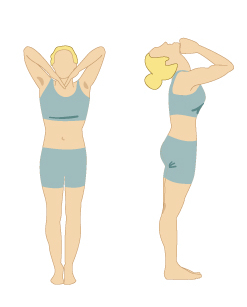
Standing Deep Breathing
Pranayama Series
Strengthens:
- Shoulders
- Deltoids
Stretches:
- Intercostal muscles – ribcage
- Shoulder joints
- Scapula
- Ocular nerve
Stimulates:
- Lungs
- Nervous System
- Circulatory System
Benefits:
- Increases lung capacity.
- Increases lung efficiency.
- Opens the shoulders.
- Wakes up the body for class.
What is happening in the posture:
This energizing breathing exercise can fill your lungs with up to six times more oxygen than a regular breath. Since oxygen is a major source of energy for the body, it is not usual to feel dizzy in the standing deep breathing. Through compression of the throat, the velocity of air entering the lungs is increased to shoot air into the lower lobes of the lungs. While your arms lift to the ceiling the ribcage opens, maximizing the inhale. Because this breath is up to six times deeper than a regular breath, it increases lung capacity while giving you quick energy.
The exhale breath detoxifies the lungs deeply. When stagnant air is pushed from the bottom of the lungs it causes a release of cellular and metabolic waste from the respiratory system. As the eyes look back to see the back wall, the ocular nerve is stimulated. With the head tilted back, the upper spine opens helping to prepare the neck for backward bending. Overall, the body is energized and the circulatory and nervous systems are stimulated, invigorating the body for class.
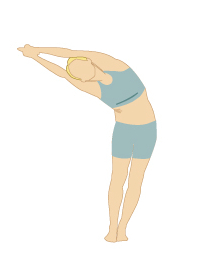
Half Moon
Ardha-Chandrasana
Strengthens:
- Every muscle in the central part of the body
- Abdominal muscles
- Back
Stretches:
- Spine
- Shoulders
- Stimulates:
- Kidneys
- Liver
- Spleen
- Lymphatic Glands
- Respiratory System
Benefits:
- Trims fat all over the body: thighs, hips, waist, buttocks, arms and abdomen.
- Improves and strengthens every muscle in the central part of the body, especially the back and abdomen.
- Increases flexibility of the spine and corrects bad posture.
- Helps pigeon chest.
- Helps release tension in the respiratory system.
- Helps cure enlargement of the liver and the spleen.
- Helps cure dyspepsia and constipation.
- Helps to alleviate lower back pain, bronchial distress, scoliotic deformities, tennis elbow, frozen shoulder.
- Realigns the spine.
- Good for lymphoma.
What is happening in the posture:
As you maintain both sides of half-moon the sides of the spine are stretched. By maintaining the form of the pose and keeping your hips and shoulders in alignment, your body receives many benefits. First the body burns fat from the thighs, waist and buttocks while the muscles of the central body are strengthened. The organs receive a massage which helps with proper digestive function. Finally the deep stretching stimulates glands and organs to help give you quick energy while maintaining the health of many body systems.
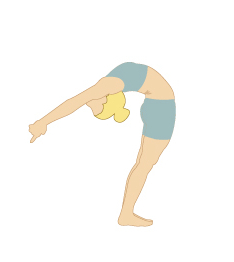
Backward Bending
Strengthens:
- Rectus Abominis
- Obliques
- Deltoid
- Trapezius
- Gluteus maximus
Stretches:
- Spine
- Shoulders
- Hips
Stimulates:
- Kidneys
- Liver
- Heart
- Circulatory System
- Nervous System
- Thyroid/ Parathyroid
Benefits:
Stimulates the sympathetic nervous system and prepares the body for action.
Helps with sciatic problems.
Helps counteract damage of bad posture.
Relieves back pain, bronchial distress, scoliotic deformities, tennis elbow, frozen shoulder.
Realigns the spine.
Regulates hormone production.
Promotes proper kidney function.
Helps with digestive function, eliminating constipation and flatulence.
Helps to relieve stress and anxiety.
What is happening in the posture:
As you bend backwards you compress the posterior part of your spinal column, pushing your disks away from the spinal nerves and decompress the front of the vertebrae. This effectively counteracts the damage of hours spent forward bending.
Those concerned and intimidated by back-bending should rest assured that the controlled environment and proper progression of the Bikram Yoga series allows for back-bends to be preformed safely.
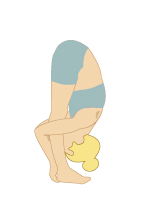
Hands to Feet Pose
Pada-Hastasana
Strengthens:
- Biceps
- Deltoids
- Quadriceps
- Calves
- Rectus Abdominis
- Trapezius muscles
Stretches:
- Hamstrings
- Spine
- Sciatic nerve
- Tendons and ligaments of the legs
- Shoulders
Stimulates:
- Pineal and pituitary glands
- Colon
- Pancreas
- Kidneys
Benefits:
- Firms and trims waistline, hips, abdomen, buttocks and thighs.
- Good for frozen shoulder.
- Relieves lower back pain.
- Good for abdominal obesity.
- Greatly enhances concentration.
- Helps with sciatic problems.
- Improves circulation to the brain and legs
What is happening in the posture:
Unlike traditional “touch-your-toes” hamstring-stretch taught in PE class, hands-to-feet pose the whole body. This is perfect example of how a pose can both work to strengthen and stretch your body. As you pull with your arms to increase flexibility, your spine, hips and legs are stretched in what Bikram calls a “360 degree stretching angle.” Completion of this pose after half-moon and backward-bending, means that the spine has been stretched in four directions, the circulatory and nervous systems have been invigorated to prepare the body for class.
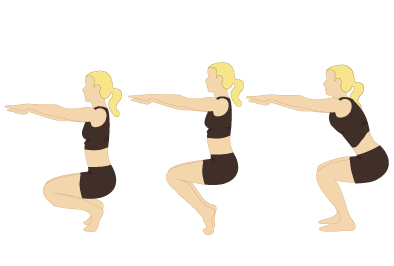
Awkward Pose
Utkatasana
Strengthens:
- Triceps
- Deltoids
- Abdominal Muscles
- Quadriceps
- Tones muscles of the legs
Stretches:
- Ankles
- Feet
- Toes
- Pelvis
- Shins
Stimulates:
- Liver
- Spleen
- Intestines
- Pancreas
Benefits:
- Helps to realign the legs to prevent lower-back pain.
- Tones the arms, getting rid fat deposits from under the arms.
- Helps to align the meniscus in the knee.
- Reduces flat feet, bunions and bowed legs.
- Helps with lumbago.
- Relieves menstrual cramps.
- Relieves sciatica.
- Reduces fat under buttocks.
- Good for arthritic conditions in knees and hips.
- Relieves joint pain.
- Helps to release anger and frustration.
What is happening in the posture:
This strength posture depends on the precise alignment of the feet to deliver the benefits. While in posture, the legs and feet are realigned helping to decrease back-pain. Essentially, the pose works almost like an orthotic. The muscles of the upper body are also profoundly strengthened by the back-bending and positioning of the arms helping with toning.
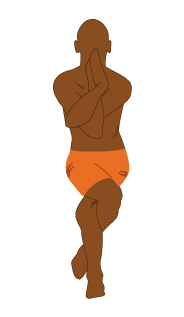
Eagle Pose
Garurasana
Strengthens:
- Muscles of the legs
- Rectum and Pineal Muscles
Stretches:
- 12 major joints of the body: shoulders, elbows, wrists, hips, knees and ankles.
Stimulates:
- Kidneys
- Reproductive Organs
- Lymphatic system
Benefits:
- Improves and maintains joint lubrication.
- Improves the mobility of the hip joint.
- Improves immune system through stimulation of the lymphatic system.
- Helps to regulate menstruation.
- Helps improve fertility.
- Good for cellulite.
- Good for varicose veins.
- Balances sexual energy.
- Good for urinary tract infections in women.
- Good for prostate health in men.
- Helps with spondylisis.
What is happening in the posture:
Eagle pose opens the major joints through stretching during the pose. As the arms and legs twist,pressure is created that irrigates the circulatory system. Blood is reserved in the muscles of the thighs, calves, arms and fore-arms. When the arms and legs release this blood flow flushes the joints helping to relieve joint problems and maintaining synovial fluid. The deep compression of this posture also massages organs and glands. Eagle pose particularity stimulates the reproductive system making this a great pose for sexual vitality and fertility.
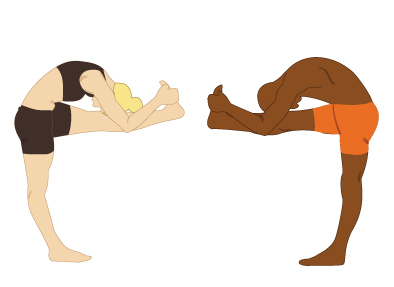
Standing Head-to-Knee Pose
Dandayamana-Janushirasana
Strengthens:
- Quadriceps muscles
- Trapezius
- Biceps
- Latissmus Dorsi
- Abdominal muscles
Stretches:
- Back
- Shoulders
- Hamstrings
Stimulates:
- Pancreas
- Thyroid, Para-Thyroid
- (in 4th stage)
- Thymus (in 4th stage)
- Digestive organs
- Reproductive organs
- Kidneys
- Heart
Benefits:
- Builds strength through the body.
- Improves flexibility of sciatic nerve.
- Strengthens tendons.
- Prevents wear and tear of knee cartilage though strengthening of soft tissues around the knee.
- Helps clear and prevent problems with digestion, including flatulence.
- Helps to develop balance.
- Helps maintain sugar levels through compression of the pancreas.
- Improves blood circulation throughout the body.
- Tones abdominal muscles and thighs.
- Improves your sex life through the massage of your reproductive organs.
- Helps to decrease varicose veins by exercising the long vein (great saphenous vein) running from the leg to the heart.
- Helps to build patience, determination and concentration.
- Helps to improve confidence and self-worth.
- Helps to clam and clear the mind.
What is happening in the posture:
Standing head-to-knee builds great concentration and determination. As the knee locks, the contraction of the thigh creates a “suspension” of the knee joint, pulling bone away from bone. By maintaining the pose, the soft tissues surrounding the knee are strengthened helping to protect the cartilage of the knee. As you bend over, the proximity of the heart to the floor, puts pressure on the muscle, exercising the heart through elevating the heart rate. The completion of all four stages of the pose profoundly strengthens the body and mind, improving confidence, focus, patience and determination.

Standing Bow Pulling Pose
Dandayamana-Dhanurasana
Strengthens:
- Quadriceps
- Gulteus Maximus
Stretches:
- Trapezius
- Latisimus Dorsi
- Sartorius
- Hamstrings
- Pectorals
- Diaphragm
- Ribcage
- Spine
Stimulates:
- Circulatory System
- Digestive System
- Reproductive System
- Urinary System
- Endocrine System
- Heart
- Kidneys
Benefits:
- Creates natural irrigation of the circulatory system – transfers blood flow from one side of the body to the other.
- Clears plaque off artery walls.
- Eases back pain through compression of the spine.
- Improves elasticity of the spine.
- Tones hips and buttocks.
- Strengthens the ankles and knees.
- Helps with frozen shoulder.
- Helps alleviate carpal tunnel, arthritis, tennis elbow.
- Helps with cervical spondylosis.
- Good for prenatal recovery.
- Stretches diaphragm and ribcage improving respiration (breathing).
- Flushes kidneys, bladder and urinary system.
- Alleviates gas, constipation and clears digestion.
- Improves balance.
- Develops determination, patience and self-confidence.
What is happening in the posture:
Standing bow-pulling pose is incredibly effective at flushing the circulatory system. The pose moves blood flow from one side of the body, dumping it into the other and creating a profound circulatory flush. Standing bow is a hugely expressive pose, helping to open the shoulders, hips, spine releasing emotion and stress from the tissues. As in standing head to knee, the position of the chest increases pressure on the heart helping to stimulate and exercise the cardiovascular system.
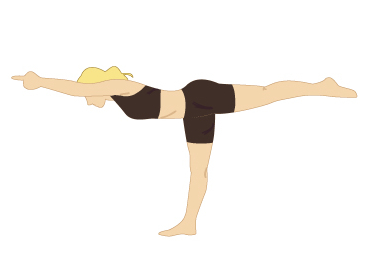
Balancing Stick
Tuladandasana
Strengthens:
- Upper Thighs
- Buttocks
- Shoulders
- Abdomen
- Trapezius Muscles
- Deltoids
- Ankles
Stretches:
- Hip Joints
- Shoulders
- Full Stretch of the spine
Stimulates:
- Pancreas
- Liver
- Spleen
- Kidneys
- Nervous System
Physical Benefits:
- Improves balance.
- Increases endurance.
- Increases lung capacity.
- Stimulates the heart and arteries, strengthening the heart.
- Helps to clear blockages from arteries helping to prevent future cardiovascular problems. Helps varicose veins.
- Burns fat (up to 300 calories during the posture according to Rajishree Choudhury.) Slims waistline and eliminates deposits fat on the body.
- Relieves tension from the spine.
- Improves memory and concentration.
What is happening in the posture:
Balancing stick is the best posture for your heart. Proper execution of the pose means that the arms and legs are positioned above the heart (except the standing leg.) This helps to flush the heart and arteries, particularity the horse-shoe artery. This makes the posture therapeutic for heart-conditions and effective for preventing heart disease and heart attack. Finally, because of the amount of muscles mass used in execution of the pose, balancing stick is one of the biggest calorie burners in the Bikram Yoga series.

Standing Separate-Leg Stretching
Dandayamana-Bibhaktapada-Paschimotthanasana
Strengthens:
- Biceps
- Trapezius
- Latissimus Dorsi
- Deltoids
Stretches:
- Hamstrings
- Entire spine
Stimulates:
- Adrenal glands
- Digestive organs
Benefits:
- Helps to increase flexibility of the spine.
- Helps to relieve depression and memory loss.
- Balances the nervous system.
- Good for digestion, hyperacidity, constipation.
- Helps reduce abdominal obesity.
- Helps with diabetes.
- Releases tension in the lower back.
- Exercises adrenal.
- Exercises the reproductive system.
What is happening in the posture:
After the intense cardio workout of the balancing postures, this pose helps to calm the nervous system, release the lower back and flush the brain. The purpose of standing separate leg stretching is to create a 360 degree stretching in the body. It is easy to focus on stretching of the legs in this pose, but it is important to work the arms and bring the stretch into the spine.
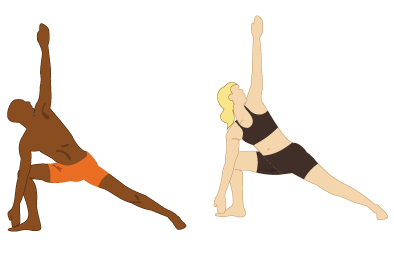
Triangle Pose
Trikanasana
Strengthens:
- Works all of the major muscle groups at the same time: arms, legs, abdomen, back
Stretches:
- Hip joints
- Shoulder joints
Stimulates:
- Kidneys
- Thyroid
- Adrenal Glands
- Cardiovascular system
Benefits:
- An excellent cardiovascular workout, with very little movement.
- Intensely stretches each side of the body.
- Reduces saddle bag.
- Good for frozen shoulder.
- Intense hip-opener.
- Helps regulate hormone levels.
- Works all muscular groups simultaneously.
- Helps with: constipation, colitis, low blood pressure, appendicitis, spondylitis, menstrual disorders.
What happens in the posture:
Triangle is the most comprehensive posture in the Bikram Yoga series. This post helps to work all of the major organs, muscles and systems of the body. Triangle involves an extreme amount of concentration. The pose cannot be executed without constant attention to form and continuos adjustment to the position of your body. Maintaining triangle pose helps to bring a harmony to the respiratory and cardiovascular systems.
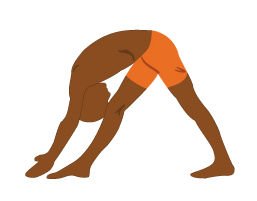
Standing Separate Leg Head to Knee Pose
Dandayamana-Bibhaktapada-Janushirasana
Strengthens:
- Abdomen
- Thighs
- Calves
- Stretches:
- Shoulders
- Stimulates:
- Thyroid / Parathyroid
- Pancreas
- Kidneys
- Entire endocrine system.
- Stimulates digestive system.
Benefits:
- Boosts the metabolism and immune system.
- Balances blood sugar levels.
- Good for diabetic conditions.
- Reduces abdominal obesity.
- Good for depression and memory loss.
- Is good for rheumatism and lower back pain.
What is happening in the posture:
The focus in standing separate forehead-to-knee is to create maximum compression in the front side of the body. This pose is often called the six pack posture because of the way that it strengthens the abs when done correctly. The endocrine system benefits the most from this posture getting a thorough compression that helps to boost the metabolism and immune system. It is important to always remember that the posture is about touching the forehead to the knee to get the benefits of the posture, and not about stretching the hamstrings.
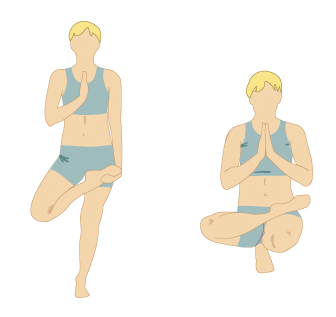
Tree Pose and Toe Stand
Tadasana
Strengthens:
- Abdomen
- Gluteal muscles
- Stretches:
- Knee and hip joints
- Lower back and spine
- Groins and inner thighs
Benefits:
- Helps with rheumatism.
- Builds balance.
- Corrects bad posture.
- Relieves lower back pain.
- Good for circulatory problems, arthritis and rheumatism.
- Relieves flat feet.
- Helps with sciatica.
What is happening in the posture:
Tree pose and toe stand are often called the postures for your posture. Both are huge hip and knee opening postures but mainly focus on creating the strength and alignment to maintain good posture and balance.
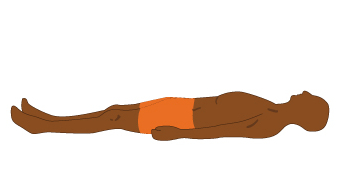
Savasana
Dead Body Pose
What is happening in the posture:
After the body has been stimulated by preforming the standing series, a two minute savasana is preformed to heal the body. Savasana is one of the most important parts of a hatha-yoga practice and it is often said that this is where the “magic” happens in the Bikram Yoga series. That magic is the healing that is created by the stillness of the pose. When the body is still the circulatory system is unobstructed and delivers oxygen, nutrients and white blood-cells to where it is needed. These materials are the building blocks of healing, which creates the therapeutic benefit of this pose.
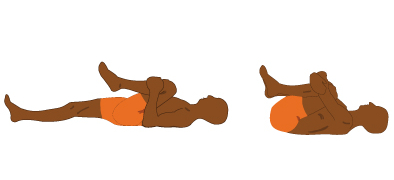
Wind-Removing Pose
Pavanamuktasana
Strengthens:
- Abdominal wall
- Thighs
- Hips
Stretches:
- Hip joints
Stimulates:
- Massages ascending, descending and transverse colon.
Benefits:
- Regulates and normalizes hydrochloric acid levels in stomach.
- Improves and may cure conditions of constipation, flatulence and hyperacidity.
- Relieves lower back pain.
- Increases peristalsis in the gut.
What is happening in the posture:
Wind-removing pose is like Bikram’s “Pepto Bismol.” This pose stimulates the ascending, descending and transverse colon as well as the stomach and small intestines. The order in which the pose is preformed helps to stimulate the bowels, cures constipation and improves nutrient absorption. The posture is called “wind-removing” for a reason, as it helps to relieve flatulence. Finally it helps to balance out hydrochloric acid levels in the stomach helping with indigestion and heartburn.

Sit-Up
Strengthens:
- Abdomen
- Stretches:
- Hamstrings
- Calf muscles
- Achilles tendons
Stimulates:
- Diaphragm
- Benefits:
- Double breath exhale helps to
- eliminate toxins from the lungs.
What is happening the posture:
The sit-up serves to invigorate the body in between poses. A quick stretch to the hamstrings, it helps to prepare and open the lower back and legs for the final stretching pose at the end of class. More importantly the double-exhale helps to release toxins from the lungs helping to energize the body in between the poses.
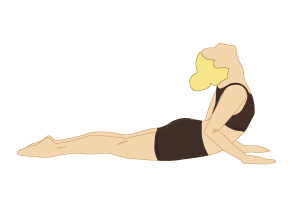
Cobra Pose
Bhujangasana
Strengthens:
- Latissimus Dorsi
- Erector Spinae
- Trapezius
- Gluteal muscles
- Abdomen
- Thighs
- Deltoids
- Biceps
Stretches:
- Hip joints
- Shoulders
- Heart and lungs
Stimulates:
- Spinous process
- Kidneys and renal system
- Digestive organs
- Reproductive organs
Benefits:
- Relieves back pain.
- Increases spinal strength and flexibility.
- Improves the function of the large and small intestines, liver, kidney and spleen.
- Improves pigeon chest by opening the rib cage.
- Permits maximum expansion of the lungs increasing oxygen intake, therapeutic for asthma.
- Improves digestion and elimination.
- Improves function of reproductive organs.
- Helps relieve lumbago, rheumatism and arthritis of the spine.
- Reduces symptoms of gout, herniated disc, sciatica, tennis elbow.
- Helps relieve menstrual problems.
- Strengthens the immune system and revitalizes the thyroid.
- Soothes sciatica.
- Looking up tones the optic nerve, improving vision.
- Helps to regulate blood pressure through compression of the kidneys and renal system.
What is happening in the posture:
Cobra pose triggers the lower back, helping with various spinal conditions. Cobra creates an intense massage of the abdomen which helps digestive function and prevents and helps to cure digestive ailments. The pelvic floor is activated in this posture helping with menstrual problems, fertility and the function of reproductive organs.
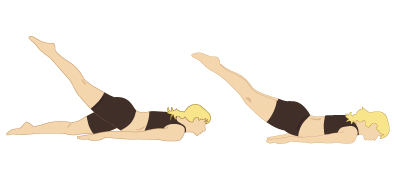
Locust Pose
Salabhasana
Strengthens:
- Erector Spinae
- Trapezius Muscles
- Latissimus Dorsi
- Abdomen
- Deltoids
- Triceps
- Pelvic Floor
- Hips
- Buttocks
Stretches:
- Elbow Joint
- Upper Back
Stimulates:
- Digestive System
- Reproductive System
- Liver
- Spleen
Benefits:
- Effective in helping conditions of slipped disc and sciatica.
- Firms buttocks and hips.
- Increases spinal strength, flexibility and circulation.
- Improves flexibility and tone of spinal muscles.
- Helps relieve and prevent backache.
- Helps cure or relieve lumbago, rheumatism and arthritis
- Relieves menstrual problems.
- Helps cure loss of appetite.
- Helps with tennis elbow, carpal tunnel syndrome and arthritis in the wrists and hands.
- Improves sluggish digestion
- Increases abdominal pressure and regulates intestinal function.
- Helps correct bad posture.
- Relieves cervical spondylosis and back pain
- Encourages concentration and perseverance.
What is happening in posture:
Locust pose helps to re-align the elbow, a joint that is naturally built to straighten but rarely does. As you lie down on top the elbow, compression blocks blood flow to the wrists and elbows in the pose. When the legs lift, the upper back is engaged to strengthen the muscles of the back and shoulders. When the pose is released pressurized blood flow flushes the elbows and wrists getting rid of calcium deposits, arthritic starts and scar tissue. Locust is also beneficial for carpal tunnel syndrome and tennis elbow and effectively maintains the dexterity of your hands.
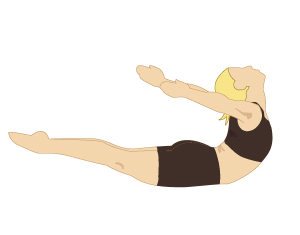
Full-Locust Pose
Poorna-Salabhasana
Strengthens:
- Lower and Upper Back
- Muscles of the upper arm (deltoids, triceps)
- Abdominal Muscles
- Buttocks
- Quadriceps
- Hamstrings
- Sartorius Muscles
- Calf Muscles
Stimulates:
- Digestive System
- Liver
- Spleen
Benefits:
Helps with poor posture, relieves and prevents lower-back pain.
Helps relieve lumbago, arthritis, rheumatism, cervical spondylosis.
Helps to massage abdominal organs, aiding with digestive problems (flatulence, constipation, indigestion.)
Helps regulate and prevent menstrual problems.
Helps with loss of appetite and fatigue.
Releases and breaks through fear, concern and overwhelming responsibility.
What is happening in the posture:
Full locust is one of the most difficult postures to improve in the Bikram Yoga series. The posture triggers and strengthens the mid-spine helping to prevent lower back pain. It is also effective at strengthening and toning the hips and buttocks.
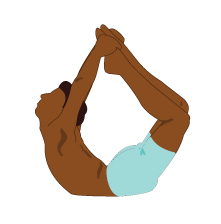
Bow Pose
Dhanurasana
Strengthens:
- Erector Spinae muscle
- Deep spinal muscles
- Deltoids
- Rhomboids
- Trapezius Muscles
- Latissmus Dorsi
Stretches:
- Entire front side of the body
- Shoulder joints
- Spinal column
Stimulates:
- Digestive system
- Kidneys
- Liver
- Thymus
- Lymph glands in neck and endocrine glands.
Benefits:
- Increases circulation to the heart and lungs.
- Improves breathing by extending and opening the diaphragm and chest.
- Increases circulation to the spine, helping to revitalize the spinal nerves.
- Tones the abdomen, improves digestion and relieves constipation.
- Helps to regulate the ovaries and prostate gland.
- Helps to relieve rheumatism, arthritis, lumbago and cervical spondylosis.
- Relieves menstrual problems.
- Stimulation of the thymus gland helps to regulate the cycle of eating, making bow good for eating disorders.
- Helps to correct bad posture.
- Alleviates fatigue.
- Good for anorexia and bulimia.
- Improves the function of the kidneys, liver and spleen.
- Good for bronchitis.
- Strengthens concentration and determination
- Develops freedom of expression.
- Relieves stress associated with taking too much responsibility for others.
What is happening in the posture:
After the strengthening benefits of cobra, locust and full locust, bow pose opens the entire spine in a deep back bend. Highly therapeutic for the spine, this pose is also beneficial for the digestive system and reproductive systems which get massaged during the posture.

Fixed Firm Pose
Supta-Vajrasana
Stretches:
- Quadriceps
- Spleen
- Lower Back
- Lymph glands in arm pits
- Ankles
- Knees
- Diaphragm
Stimulates:
- Lymphatic System
- Adrenal glands
- Kidneys
- Liver
- Pancreas
- Digestive System
Benefits:
- Improves circulation to kidneys, liver, pancreas and bowels.
- Rebuilds the flexibility of the knees and ankles
- Helps to boost the immune system through stimulation of the spleen.
- Helps to stimulate the lymphatic system, particularly the lymph glands of the arm-pit.
- Helps with digestion problems including indigestion, gas, constipation.
- Good for asthma and respiratory conditions.
- Helps to flush knees and ankles of calcium deposits, scar tissue and arthritic starts.
- Helps to minimize menstrual pain.
- Helps with sciatica, gout and varicose veins.
- Helps to activate kundalini energy.
- Maintains sexual longevity with age.
What is happening in the posture:
Fixed-firm is the knee healer in the Bikram series. This posture evenly stretches all of the major ligaments in the knees and ankles in an anatomically correct position. This means it rebuilds the natural flexibility of the knees and ankles. While in the posture, compression of the circulatory system decreases blood flow to these joints and then flushes them to eliminate scar-tissue, arthritic starts and calcium deposits in the joints. It is also massages the lymph system which is highly beneficial for the immune system.

Half-Tortoise Pose
Ardha-Kurmasana
Stretches:
- Shoulders
- Deltoids
- Scapula
- Trapezius
- Latissimus Dorsi
- Hips
Strengthens:
- Abdomen
- Quadriceps
Stimulates:
- Pituitary Gland
- Pineal Gland
- Hypo-thalmus
- Lungs
Benefits:
- A rejuvenation pose providing maximum relaxation.
- Relieves digestion problems and constipation.
- Stretches lower part of the lungs, increases lung capacity.
- Excellent for respiratory conditions.
- Increases circulation to the brain.
- Improves mobility of shoulder girdle.
- Relieves stress and migraines.
- Helps with insomnia.
- Helps with jet-lag.
- Helps to increase circulation to facial muscles, helping to prevent and erase the signs of aging.
What is happening in posture:
Half tortoise increases circulation to the brain stimulating the pineal and pituitary gland helping to regulate serotonin and melatonin. This helps to balance sleep cycles and prevent and cure depression. It is often said that this posture is equivalent to eight of hours of sleep. This is because in the pose, so much oxygen and nutrients are carried to the brain that the only way to get the same benefit is to sleep for eight hours.
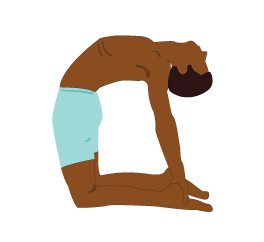
Camel Pose
Ustrasana
Strengthens:
- Trapezius Muscles
- Latissimus Dorsi
- Erector Spinae
Stretches:
- Rib cage
- Diaphragm
- Throat
Stimulates:
- Respiratory System
- Cardiovascular System
- Nervous System
- Endocrine Glands
Benefits:
- Tones and stretches muscles and nerves attached to the spine.
- Compresses spine, relieving back problems.
- Good for diabetes.
- Helps with spondylitis of cervical, thoracic and lumbar spine.
- Helps with bronchial problems.
- Improves flexion of neck and spine.
- Flushes fresh blood through kidneys.
- Helps eliminate toxins.
- Good for vocal disorders.
- Helps with genito-urinary disorders of the kidneys, urinary bladder, ovaries, testes and prostate.
- Helps gastro-intestinal disorders: constipation, colitis, dyspepsia, liver and gall bladder problems.
What is happening in the posture:
Camel pose is the deepest back-bend in the Bikram series. Camel is a hugely emotional posture that releases much stress and anxiety from the chest. It invigorates the nervous system and helps to heal many different spinal ailments.

Rabbit Pose
Sasangasana
Strengthens:
- Abdomen
Stretches:
- Muscles of the back
- Shoulders
- Scapula
- Medulla Oblongata
Stimulates:
- Thyroid
- Parathyroid
Benefits:
- Provides maximum longitudinal extension of the spine
- Stretches the spine to increase proper nutrition to the nervous system
- Improves the mobility and elasticity of the spine and back muscles
- Helps balance and regulate metabolism.
- Balances hormones.
- Improves digestion.
- Helps relieve glandular problems .
- Helps improve conditions of the sinus, common cold and chronic tonsillitis
- Helps insomnia.
- Helps with depression.
What is happening in the posture:
Rabbit pose is the prefect balance to camel pose. The postures work together to deeply stretch and open the spine. Rabbit helps to open the inter-vertebral disks, helping to maintain their spongy nature and absorb shock in spine from daily movement. It helps to stretch the spine so effectively that with a regular practice many people report growing up to one inch. The stretch in rabbit is created by the pull on the heels, so it is important to always keep a tight grip in order to create enough force to stretch the spine.
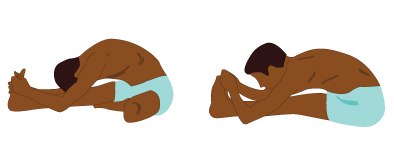
Head-to-Knee and Stretching Pose
Janushirasana with Paschimotthanasana
Stretches:
- Hamstrings
- Trapezius
- Last 5 vertebra of the spine
- Sciatic nerve
- Hip joints
Strengthens:
- Biceps
- Deltoids
- Abdomen
- Thighs
Stimulates:
- Liver
- Spleen
- Pancreas
- Thymus Gland
- Thyroid
- Parathyroid
- Digestive System
- Immune System
Benefits:
- Head to knee pose helps balance blood sugar levels and the metabolism.
- Improves flexibility of sciatic nerve and ankle, knee and hip joints.
- Enhances kidney function.
- Increases circulation to liver, spleen and pancreas.
- Stimulates thymus gland, digestion and immune system.
- Stimulates and tones the digestive organs, increases peristalsis, relieves constipation and other digestive problems.
- Regulates function of the pancreas, assisting those with diabetes or hypoglycaemia.
- Mobilizes joints and increases elasticity in the lumbar spine.
- Relieves compression of the spine and sciatica.
- Improves concentration and mental endurance.
- Reverses flow of kundalni energy, distributing it through the spine, improving creativity.
What is happening in the posture:
Forehead-to-knee once again compresses the front side of the body deeply massaging the pancreas, helping to regulate blood sugar. The posture is like doing a seated standing head-to-knee and is a good opportunity to practice perfecting the form without worrying about balance. The kidneys are also extended in this posture helping with the function of the renal system.
The final forward stretch helps to extend the legs and stretch the spine in a 360 degree angle. It is a pose that is incredibly effective for releasing tension from the hamstrings and the lower back.
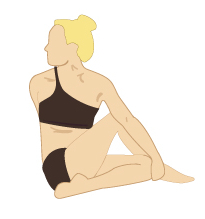
Spine Twisting Pose
Ardha-Matsyendrasana
Strengthens:
- Buttocks
- Thighs
- Abdomen
Stretches:
- Joints and vertebra of the spine
- Spinal nerves
- Hips
Stimulates:
- Digestive System
- Kidneys
- Liver
- Gall Bladder
- Spleen
Benefits:
- Compresses and stretches spine from the bottom to the top.
- Improves digestion.
- Improves elasticity, flexibility, circulation and nutrition to spinal nerves, vessels and tissues.
- Increases synovial fluid of the joints.
- Removes adhesions in the joints caused by rheumatism.
- Tones the roots of the spinal nerves and sympathetic nervous system
- Detoxifies the spine.
- Opens bronchial muscles and rib cage.
- Helps prevent slipped disc.
- Relieves lower back pain.
- Helps sciatica and arthritis of the knee.
What is happening in the posture:
After compressing, decompressing, twisting and bending the spine in four directions, the final spine twist is the last detoxification for the vertebral column. A good massage for the abdominal organs, the primary focus is to twist and, like a wet rag, release all the toxins from the spine.

Blowing in Firm Pose
Khapalbhati
Strengthens:
- Abdomen
Stimulates:
- Digestive System
- Respiratory System
Benefits:
- Detoxifies and cleanses body by removing stale air and toxins from lungs
- Brings mental clarity
- Normalizes digestion and bowel movements.
- Energizes body.
- Calms the nervous system.
- Improves oxygenation to the body.
- Improves cardiovascular and respiratory systems.
- Good for high blood pressure.
What is happening in the posture:
Kapalbhati breathing is the most effective yogic breathing exercise for detoxifying the lower lungs, where many toxins accumulate. It also works the abdominal muscles like a sit up exercise. Finally it helps to calm the nervous system and cool down the body’s core temperature to help prepare for cooler temperatures outside the hot room.